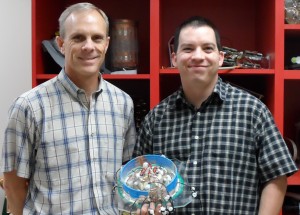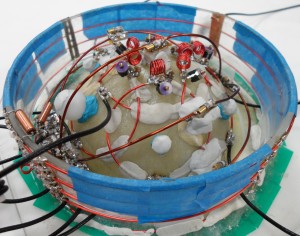
A team from BYU and University of Utah are setting aside the rivalry to advance breast cancer detection.
The team has developed a coil that fits inside an MRI machine to provide readings of sodium levels in the breast three to five times more clearly than previous sodium MRI readings.
It is the team’s hope that breast cancer detection will be enhanced by advances in sodium MRI technology and eventually lead to fewer false positives. High sodium can lead tumor development.
The team has already received funding and approval to test sodium MRIs on 20 breast cancer patients. Dr. Glen Morrell, a professor of radiology at the University of Utah, will be overseeing the scanning of patients at the University of Utah. Dennis Parker, another professor of radiology, is also working with the team on the coil project.
BYU electrical engineering professor and team member Neal Bangerter has high expectations for the coil.
“Our hope is that we can use that additional physiological information to eventually improve the diagnosis and characterization of breast cancer,” Bangerter said.
The project started at Stanford in 2006 when Bangerter was a research scientist in Stanford’s Department of Radiology. Bangerter’s team originally began work on sodium MRI to look at degenerative changes in cartilage, especially in the knee.
In 2007, Bangerter and the Stanford team read the work of Ronald Ouwerkerk, who began using sodium MRI for breast cancer research. They realized the sodium MRI techniques they developed for cartilage research could be adapted for breast cancer imaging and secured a grant from the State of California to begin research. Bangerter left Stanford and came to BYU, where he continued working on the project in collaboration with the University of Utah.

Bruce Daniel, a Stanford professor of radiology and former collaborator with Bangerter, still has an active interest in the project.
“Bangerter and his group have invented a way to dramatically boost the sodium signal from the breast, enabling much better, higher resolution sodium MR images to be obtained,” Daniel said in a statement. “This should open the door to new avenues of research into breast cancer, especially the ways that breast cancers grow.”
Josh Kaggie, a University of Utah doctorate student in physics, is the main author of a paper detailing the coil’s design and function. Kaggie worked on the project under the direction of Bangerter and Rock Hadley, a University of Utah radiology professor. Kaggie played a key role in designing and building the coil.
“Through my involvement with the project I’ve learned that sometimes simple but great techniques are overlooked,” Kaggie said. “There wasn’t anything special about the coil; it’s just that no one else had done it before.”
Kaggie wants to expand the use of the technology in the future.
“Eventually, I’d like to implement this technology for diagnosis of cartilage health in the knees or for determining the health of the kidneys,” Kaggie said.
Bangerter warns that sodium MRIs may not be commonly used for some time. The technique is an add-on to already-expensive MRI scans, and the process of translating the technique from the laboratory to clinical practice could take years.




